
Damsels
with
Philip Rowley
Website
| Email
Considered a stillwater
staple, damsel flies are available in some shape
or form year round. The damsel nymphs active habits
constantly place them at risk. Whenever I explore new
waters a damsel nymph pattern is a favorite choice. The
bold nymphs are an accustomed sight to the foraging
trout.
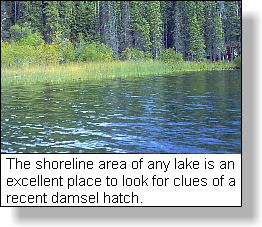 Damsels belong to the
order Odonata, one of the oldest and most
primitive with species dating back to prehistoric times.
With over twenty known species damsels are widespread
across North America. Damsels are available to the stream
angler too. Damsels also inhabit slow moving rivers and
streams. Lakes and ponds are a favored haunt. Here their
aggressive behavior exposes them to foraging fish.
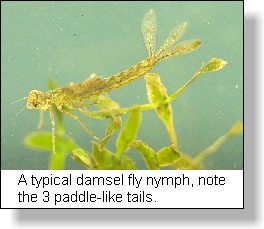 Damsels have an incomplete
metamorphosis. Some species spend up to 2 years as a
nymph, although cycles of 1 year are more common. The
nymphs are aggressive predators. Damsels use their lower
jaw to capture prey in a frog-like fashion. Favorite prey
includes: scuds, chironomid larvae, mayflies and even
each other. Damsel fly nymphs are sight feeders. Their
prominent eyes investigate any suspicious movement.
Damsel fly nymphs are a long skinny creatures with three
paddle like tails. The tails are actually gills and
provide balance and stability. Damsel nymphs reach up to
1 1/4 inches at maturity. Damsel nymphs come in a host of
colors from dark brown, to light olive and dark green.
Vegetation is a great clue to choosing the right color
pattern. Weed beds are a favorite location for damsel fly
nymphs. Damsel nymphs favor long stemmed weeds waiting in
ambush on the undersides of the leaves. Damsel nymphs are
steady swimmers. The nymphs plod along with a sculling
motion coupled with rests. Damsel nymphs hold their legs
out stretched when swimming to provide stability. Mature
damsel nymphs swim en masse slightly sub surface towards
shore to emerge. Migration occurs in the late spring and
early summer. The best time to see this migration is the
late morning or mid afternoon. Damsel fly nymphs crawl
out of the water to emerge. Any structure will do. This
includes anchor ropes or crawling up your float tube or
kick boat. Take the time to observe the transformation
from nymph to adult. It is one of the miracles of nature.
The newly emerged adult or teneral becomes prey for other
insects, birds and trout. Trout rub against the tulles,
knocking the hapless insects into the water. The trout
returns to leisurely scoop up the floundering tenerals.
The adult has a slender abdomen and holds its wings
parallel to the body while at rest. Capable fliers,
damsel flies feed upon insects such as mosquitoes and
chironomids. Damsels have an incomplete
metamorphosis. Some species spend up to 2 years as a
nymph, although cycles of 1 year are more common. The
nymphs are aggressive predators. Damsels use their lower
jaw to capture prey in a frog-like fashion. Favorite prey
includes: scuds, chironomid larvae, mayflies and even
each other. Damsel fly nymphs are sight feeders. Their
prominent eyes investigate any suspicious movement.
Damsel fly nymphs are a long skinny creatures with three
paddle like tails. The tails are actually gills and
provide balance and stability. Damsel nymphs reach up to
1 1/4 inches at maturity. Damsel nymphs come in a host of
colors from dark brown, to light olive and dark green.
Vegetation is a great clue to choosing the right color
pattern. Weed beds are a favorite location for damsel fly
nymphs. Damsel nymphs favor long stemmed weeds waiting in
ambush on the undersides of the leaves. Damsel nymphs are
steady swimmers. The nymphs plod along with a sculling
motion coupled with rests. Damsel nymphs hold their legs
out stretched when swimming to provide stability. Mature
damsel nymphs swim en masse slightly sub surface towards
shore to emerge. Migration occurs in the late spring and
early summer. The best time to see this migration is the
late morning or mid afternoon. Damsel fly nymphs crawl
out of the water to emerge. Any structure will do. This
includes anchor ropes or crawling up your float tube or
kick boat. Take the time to observe the transformation
from nymph to adult. It is one of the miracles of nature.
The newly emerged adult or teneral becomes prey for other
insects, birds and trout. Trout rub against the tulles,
knocking the hapless insects into the water. The trout
returns to leisurely scoop up the floundering tenerals.
The adult has a slender abdomen and holds its wings
parallel to the body while at rest. Capable fliers,
damsel flies feed upon insects such as mosquitoes and
chironomids.
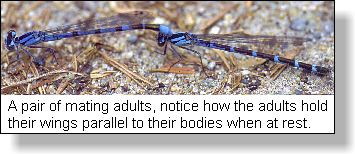 Damsel flies are aggressive
lovers. The male grasps the female with a pair of
claspers behind her head. In this tandem position mating
takes place. The female lays her eggs, often still
attached to the male. Some species oviposit by dropping
their eggs from above or by dipping their abdomen in the
water. I have seen some females crawl below the waters'
surface and deposit their eggs directly into the
vegetation. The adults continue on throughout the summer
and fall until the first frosts of the year kill them. Damsel flies are aggressive
lovers. The male grasps the female with a pair of
claspers behind her head. In this tandem position mating
takes place. The female lays her eggs, often still
attached to the male. Some species oviposit by dropping
their eggs from above or by dipping their abdomen in the
water. I have seen some females crawl below the waters'
surface and deposit their eggs directly into the
vegetation. The adults continue on throughout the summer
and fall until the first frosts of the year kill them.
Presentation:
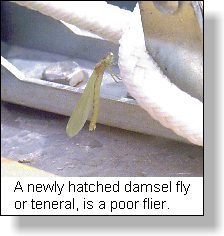 Popular
lines for imitating the nymph include: floating,
intermediate and sinking lines. In non hatch situations'
imitate the immature nymphs on or near the bottom. Leader
lengths from 9 to 15 feet are fine. My favorite retrieve
is a slow hand twist coupled with pauses. Gary Borgers'
strip tease retrieve works well too. The strip tease
retrieve consists of a slow one foot pull while vibrating
your rod tip up and down with your casting hand. The
vibrating rod tip causes the fly to jiggle in the same
manner as the swimming nymphs. Trolling damsel nymph
patterns is another good tactic. As I explore a new lake
a slowly trolled damsel nymph pattern has always worked
well. When fishing a hatch situation, it is important to
retrieve your pattern in the same direction as the
migrating nymphs. Anchoring near the tulles or long stem
bull rushes is an exciting way to fish. Trout will follow
the migrating nymphs into very shallow waters. Aggressive
rises are an indicator trout are feasting on the nymphs.
To determine if a hatch has taken place make a habit of
checking the shoreline vegetation. Look for the tenerals
or cast husks of the nymphs on the tulles or long stemmed
bull rushes. Popular
lines for imitating the nymph include: floating,
intermediate and sinking lines. In non hatch situations'
imitate the immature nymphs on or near the bottom. Leader
lengths from 9 to 15 feet are fine. My favorite retrieve
is a slow hand twist coupled with pauses. Gary Borgers'
strip tease retrieve works well too. The strip tease
retrieve consists of a slow one foot pull while vibrating
your rod tip up and down with your casting hand. The
vibrating rod tip causes the fly to jiggle in the same
manner as the swimming nymphs. Trolling damsel nymph
patterns is another good tactic. As I explore a new lake
a slowly trolled damsel nymph pattern has always worked
well. When fishing a hatch situation, it is important to
retrieve your pattern in the same direction as the
migrating nymphs. Anchoring near the tulles or long stem
bull rushes is an exciting way to fish. Trout will follow
the migrating nymphs into very shallow waters. Aggressive
rises are an indicator trout are feasting on the nymphs.
To determine if a hatch has taken place make a habit of
checking the shoreline vegetation. Look for the tenerals
or cast husks of the nymphs on the tulles or long stemmed
bull rushes.
Occasionally trout feed
upon the adults. If conditions are right trout will feed
upon the newly hatched tenerals and egg laying females.
An adult pattern presented dead drift is a good tactic.
Make your fly struggle by adding the odd twitch. Use a
stout leader, hooked trout will try to escape by dragging
you through the shoreline vegetation.
Trout will seldom pass up
a well-presented damsel fly pattern. When fishing is
tough or sporadic a damsel nymph pattern is a favorite
choice. Just about every lake or pond has a population of
damsel flies. They are a year round food source for the
fish. They are an integral part of my fly box and fishing
strategies.
A Couple of My Favorite
Damsel Fly Patterns:
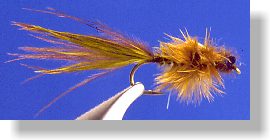 Phil's Aftershaft Damsel Phil's Aftershaft Damsel
Hook: Tiemco 5262 #12-#8
Thread: Color to Suit
Tail: Marabou
Rib: Fine Wire
Body: Marabou Wound By Tips
Wingcase: Raffia
Thorax: Filoplume
Eyes: Knotted Plush Chenille
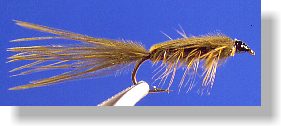 Denny Rickard's
Stillwater Nymph Denny Rickard's
Stillwater Nymph
Hook: Tiemco 5262 #12-#8
Thread: Olive 6/0 or 8/0
Tail: Marabou (Color to Suit)
Shellback: Marabou Butts From Tail Material
Rib: Fine Wire
Hackle: Orange Grizzly Wound a Maxium of 4 Times Over Body
Body: Seals' Fur (Color to Suit)

Philip Rowley
|





 Damsels have an incomplete
metamorphosis. Some species spend up to 2 years as a
nymph, although cycles of 1 year are more common. The
nymphs are aggressive predators. Damsels use their lower
jaw to capture prey in a frog-like fashion. Favorite prey
includes: scuds, chironomid larvae, mayflies and even
each other. Damsel fly nymphs are sight feeders. Their
prominent eyes investigate any suspicious movement.
Damsel fly nymphs are a long skinny creatures with three
paddle like tails. The tails are actually gills and
provide balance and stability. Damsel nymphs reach up to
1 1/4 inches at maturity. Damsel nymphs come in a host of
colors from dark brown, to light olive and dark green.
Vegetation is a great clue to choosing the right color
pattern. Weed beds are a favorite location for damsel fly
nymphs. Damsel nymphs favor long stemmed weeds waiting in
ambush on the undersides of the leaves. Damsel nymphs are
steady swimmers. The nymphs plod along with a sculling
motion coupled with rests. Damsel nymphs hold their legs
out stretched when swimming to provide stability. Mature
damsel nymphs swim en masse slightly sub surface towards
shore to emerge. Migration occurs in the late spring and
early summer. The best time to see this migration is the
late morning or mid afternoon. Damsel fly nymphs crawl
out of the water to emerge. Any structure will do. This
includes anchor ropes or crawling up your float tube or
kick boat. Take the time to observe the transformation
from nymph to adult. It is one of the miracles of nature.
The newly emerged adult or teneral becomes prey for other
insects, birds and trout. Trout rub against the tulles,
knocking the hapless insects into the water. The trout
returns to leisurely scoop up the floundering tenerals.
The adult has a slender abdomen and holds its wings
parallel to the body while at rest. Capable fliers,
damsel flies feed upon insects such as mosquitoes and
chironomids.
Damsels have an incomplete
metamorphosis. Some species spend up to 2 years as a
nymph, although cycles of 1 year are more common. The
nymphs are aggressive predators. Damsels use their lower
jaw to capture prey in a frog-like fashion. Favorite prey
includes: scuds, chironomid larvae, mayflies and even
each other. Damsel fly nymphs are sight feeders. Their
prominent eyes investigate any suspicious movement.
Damsel fly nymphs are a long skinny creatures with three
paddle like tails. The tails are actually gills and
provide balance and stability. Damsel nymphs reach up to
1 1/4 inches at maturity. Damsel nymphs come in a host of
colors from dark brown, to light olive and dark green.
Vegetation is a great clue to choosing the right color
pattern. Weed beds are a favorite location for damsel fly
nymphs. Damsel nymphs favor long stemmed weeds waiting in
ambush on the undersides of the leaves. Damsel nymphs are
steady swimmers. The nymphs plod along with a sculling
motion coupled with rests. Damsel nymphs hold their legs
out stretched when swimming to provide stability. Mature
damsel nymphs swim en masse slightly sub surface towards
shore to emerge. Migration occurs in the late spring and
early summer. The best time to see this migration is the
late morning or mid afternoon. Damsel fly nymphs crawl
out of the water to emerge. Any structure will do. This
includes anchor ropes or crawling up your float tube or
kick boat. Take the time to observe the transformation
from nymph to adult. It is one of the miracles of nature.
The newly emerged adult or teneral becomes prey for other
insects, birds and trout. Trout rub against the tulles,
knocking the hapless insects into the water. The trout
returns to leisurely scoop up the floundering tenerals.
The adult has a slender abdomen and holds its wings
parallel to the body while at rest. Capable fliers,
damsel flies feed upon insects such as mosquitoes and
chironomids. Damsel flies are aggressive
lovers. The male grasps the female with a pair of
claspers behind her head. In this tandem position mating
takes place. The female lays her eggs, often still
attached to the male. Some species oviposit by dropping
their eggs from above or by dipping their abdomen in the
water. I have seen some females crawl below the waters'
surface and deposit their eggs directly into the
vegetation. The adults continue on throughout the summer
and fall until the first frosts of the year kill them.
Damsel flies are aggressive
lovers. The male grasps the female with a pair of
claspers behind her head. In this tandem position mating
takes place. The female lays her eggs, often still
attached to the male. Some species oviposit by dropping
their eggs from above or by dipping their abdomen in the
water. I have seen some females crawl below the waters'
surface and deposit their eggs directly into the
vegetation. The adults continue on throughout the summer
and fall until the first frosts of the year kill them.  Popular
lines for imitating the nymph include: floating,
intermediate and sinking lines. In non hatch situations'
imitate the immature nymphs on or near the bottom. Leader
lengths from 9 to 15 feet are fine. My favorite retrieve
is a slow hand twist coupled with pauses. Gary Borgers'
strip tease retrieve works well too. The strip tease
retrieve consists of a slow one foot pull while vibrating
your rod tip up and down with your casting hand. The
vibrating rod tip causes the fly to jiggle in the same
manner as the swimming nymphs. Trolling damsel nymph
patterns is another good tactic. As I explore a new lake
a slowly trolled damsel nymph pattern has always worked
well. When fishing a hatch situation, it is important to
retrieve your pattern in the same direction as the
migrating nymphs. Anchoring near the tulles or long stem
bull rushes is an exciting way to fish. Trout will follow
the migrating nymphs into very shallow waters. Aggressive
rises are an indicator trout are feasting on the nymphs.
To determine if a hatch has taken place make a habit of
checking the shoreline vegetation. Look for the tenerals
or cast husks of the nymphs on the tulles or long stemmed
bull rushes.
Popular
lines for imitating the nymph include: floating,
intermediate and sinking lines. In non hatch situations'
imitate the immature nymphs on or near the bottom. Leader
lengths from 9 to 15 feet are fine. My favorite retrieve
is a slow hand twist coupled with pauses. Gary Borgers'
strip tease retrieve works well too. The strip tease
retrieve consists of a slow one foot pull while vibrating
your rod tip up and down with your casting hand. The
vibrating rod tip causes the fly to jiggle in the same
manner as the swimming nymphs. Trolling damsel nymph
patterns is another good tactic. As I explore a new lake
a slowly trolled damsel nymph pattern has always worked
well. When fishing a hatch situation, it is important to
retrieve your pattern in the same direction as the
migrating nymphs. Anchoring near the tulles or long stem
bull rushes is an exciting way to fish. Trout will follow
the migrating nymphs into very shallow waters. Aggressive
rises are an indicator trout are feasting on the nymphs.
To determine if a hatch has taken place make a habit of
checking the shoreline vegetation. Look for the tenerals
or cast husks of the nymphs on the tulles or long stemmed
bull rushes.  Phil's Aftershaft Damsel
Phil's Aftershaft Damsel Denny Rickard's
Stillwater Nymph
Denny Rickard's
Stillwater Nymph
